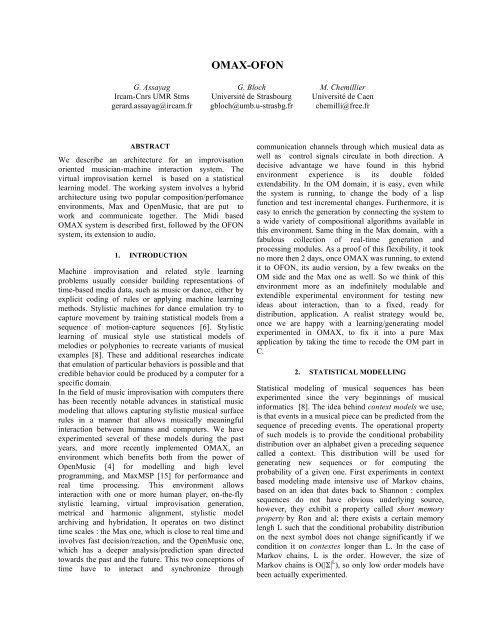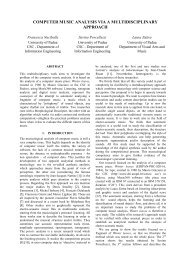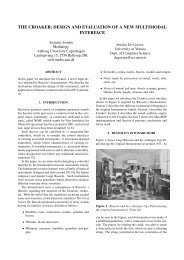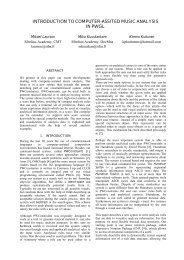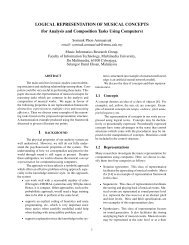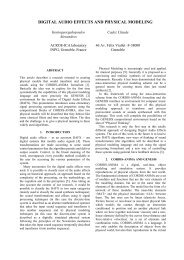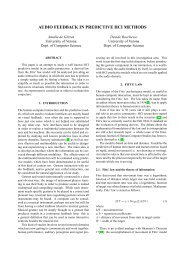OMAX-OFON - Sound and Music Computing
OMAX-OFON - Sound and Music Computing
OMAX-OFON - Sound and Music Computing
Create successful ePaper yourself
Turn your PDF publications into a flip-book with our unique Google optimized e-Paper software.
G. Assayag<br />
Ircam-Cnrs UMR Stms<br />
gerard.assayag@ircam.fr<br />
<strong>OMAX</strong>-<strong>OFON</strong><br />
G. Bloch<br />
Université de Strasbourg<br />
gbloch@umb.u-strasbg.fr<br />
M. Chemillier<br />
Université de Caen<br />
chemilli@free.fr<br />
ABSTRACT<br />
We describe an architecture for an improvisation<br />
oriented musician-machine interaction system. The<br />
virtual improvisation kernel is based on a statistical<br />
learning model. The working system involves a hybrid<br />
architecture using two popular composition/perfomance<br />
environments, Max <strong>and</strong> Open<strong>Music</strong>, that are put to<br />
work <strong>and</strong> communicate together. The Midi based<br />
<strong>OMAX</strong> system is described first, followed by the <strong>OFON</strong><br />
system, its extension to audio.<br />
1. INTRODUCTION<br />
Machine improvisation <strong>and</strong> related style learning<br />
problems usually consider building representations of<br />
time-based media data, such as music or dance, either by<br />
explicit coding of rules or applying machine learning<br />
methods. Stylistic machines for dance emulation try to<br />
capture movement by training statistical models from a<br />
sequence of motion-capture sequences [6]. Stylistic<br />
learning of musical style use statistical models of<br />
melodies or polyphonies to recreate variants of musical<br />
examples [8]. These <strong>and</strong> additional researches indicate<br />
that emulation of particular behaviors is possible <strong>and</strong> that<br />
credible behavior could be produced by a computer for a<br />
specific domain.<br />
In the field of music improvisation with computers there<br />
has been recently notable advances in statistical music<br />
modeling that allows capturing stylistic musical surface<br />
rules in a manner that allows musically meaningful<br />
interaction between humans <strong>and</strong> computers. We have<br />
experimented several of these models during the past<br />
years, <strong>and</strong> more recently implemented <strong>OMAX</strong>, an<br />
environment which benefits both from the power of<br />
Open<strong>Music</strong> [4] for modelling <strong>and</strong> high level<br />
programming, <strong>and</strong> MaxMSP [15] for performance <strong>and</strong><br />
real time processing. This environment allows<br />
interaction with one or more human player, on-the-fly<br />
stylistic learning, virtual improvisation generation,<br />
metrical <strong>and</strong> harmonic alignment, stylistic model<br />
archiving <strong>and</strong> hybridation. It operates on two distinct<br />
time scales : the Max one, which is close to real time <strong>and</strong><br />
involves fast decision/reaction, <strong>and</strong> the Open<strong>Music</strong> one,<br />
which has a deeper analysis/prediction span directed<br />
towards the past <strong>and</strong> the future. This two conceptions of<br />
time have to interact <strong>and</strong> synchronize through<br />
communication channels through which musical data as<br />
well as control signals circulate in both direction. A<br />
decisive advantage we have found in this hybrid<br />
environment experience is its double folded<br />
extendability. In the OM domain, it is easy, even while<br />
the system is running, to change the body of a lisp<br />
function <strong>and</strong> test incremental changes. Furthermore, it is<br />
easy to enrich the generation by connecting the system to<br />
a wide variety of compositional algorithms available in<br />
this environment. Same thing in the Max domain, with a<br />
fabulous collection of real-time generation <strong>and</strong><br />
processing modules. As a proof of this flexibility, it took<br />
no more then 2 days, once <strong>OMAX</strong> was running, to extend<br />
it to <strong>OFON</strong>, its audio version, by a few tweaks on the<br />
OM side <strong>and</strong> the Max one as well. So we think of this<br />
environment more as an indefinitely modulable <strong>and</strong><br />
extendible experimental environment for testing new<br />
ideas about interaction, than to a fixed, ready for<br />
distribution, application. A realist strategy would be,<br />
once we are happy with a learning/generating model<br />
experimented in <strong>OMAX</strong>, to fix it into a pure Max<br />
application by taking the time to recode the OM part in<br />
C.<br />
2. STATISTICAL MODELLING<br />
Statistical modeling of musical sequences has been<br />
experimented since the very beginnings of musical<br />
informatics [8]. The idea behind context models we use,<br />
is that events in a musical piece can be predicted from the<br />
sequence of preceding events. The operational property<br />
of such models is to provide the conditional probability<br />
distribution over an alphabet given a preceding sequence<br />
called a context. This distribution will be used for<br />
generating new sequences or for computing the<br />
probability of a given one. First experiments in context<br />
based modeling made intensive use of Markov chains,<br />
based on an idea that dates back to Shannon : complex<br />
sequences do not have obvious underlying source,<br />
however, they exhibit a property called short memory<br />
property by Ron <strong>and</strong> al; there exists a certain memory<br />
lengh L such that the conditional probability distribution<br />
on the next symbol does not change significantly if we<br />
condition it on contextes longer than L. In the case of<br />
Markov chains, L is the order. However, the size of<br />
Markov chains is O(|Σ| L ), so only low order models have<br />
been actually experimented.
To cope with the model order problem, in earlier works<br />
[3, 10-13] we have proposed a method for building<br />
musical style analyzers <strong>and</strong> generators based on several<br />
algorithms for prediction of discrete sequences using<br />
Variable Markov Models (VMM). The class of these<br />
algorithms is large <strong>and</strong> we focused mainly on two<br />
variants of predictors - universal prediction based on<br />
Incremental Parsing (IP) <strong>and</strong> prediction based on<br />
Probabilistic Suffix Trees (PST).<br />
From these early experiences we have drawn a series of<br />
prescriptions for an interactive music learning <strong>and</strong><br />
generating method. In the following, we consider a<br />
learning algorithm, that builds the statistical model from<br />
musical samples, <strong>and</strong> a generation algorithm, that walks<br />
the model <strong>and</strong> generates a musical stream by predicting<br />
at each step the next musical unit from the already<br />
generated sequence. These prescription could be<br />
summed up as :<br />
• learning must be incremental <strong>and</strong> fast in order to be<br />
compatible with real-time interaction, <strong>and</strong> be able<br />
to switch instantly to generation (real-time<br />
alternation of learning <strong>and</strong> generating can be seen as<br />
« machine improvisation » where the machine<br />
« reacts » to other musician playing).<br />
• The generation of each musical unit must bounded<br />
in time for compatibility with a real time scheduler<br />
• In order to cope with the variety of musical sources,<br />
it is interesting to be able to maintain several models<br />
<strong>and</strong> switch between them at generation time.<br />
• Assuming the parametric complexity of music<br />
(multi-dimensionality <strong>and</strong> multi-scale structures)<br />
multi-attribute models must be searched for, or at<br />
least a mechanism must be provided for h<strong>and</strong>ling<br />
polyphony.<br />
We have chosen for <strong>OMAX</strong> a model named factor<br />
oracle (FO) that conforms with points 1, 2 <strong>and</strong> 4. It is<br />
described in [1] <strong>and</strong> its application to music data is<br />
described in [2]. An exemple is given in figure 1.<br />
A<br />
B<br />
B<br />
0 1 2 3 4<br />
Figure 1. A factor oracle for the string ABABABABAABB.<br />
FO are basically automata that capture all sub-phrases<br />
(factors) in a sequence of symbols, transformed into a<br />
linear chain of states by an efficient incremental<br />
algorithm. Through this transformation, the sequence<br />
structure is “learned” into the FO. The states are linked<br />
B<br />
A B A B A B A A B B<br />
A<br />
by two kind of arrows. Forward arrrows are called factor<br />
links. By following these at generation time, it is possible<br />
to generate factors of the original sequence, i.e. litterally<br />
repeat learned subsequences. Backward arrows are called<br />
suffix links. By following these, it is possible to switch to<br />
another subsequence sharing a common suffix with the<br />
current position. Such a recombination, is really a context<br />
based generation, the context being the common suffix.<br />
Although the probability model has not yet been defined,<br />
Fo’s are conjectured to be VMM.<br />
3. <strong>OMAX</strong> ARCHITECTURE<br />
<strong>OMAX</strong> is distributed across two computer music<br />
environments : Open<strong>Music</strong> <strong>and</strong> Max. Obviously, the<br />
Max components are dedicated to real-time interaction,<br />
instrumental capture, Midi <strong>and</strong> audio control, while<br />
Open<strong>Music</strong> components are specialized in higher level<br />
operations such as building <strong>and</strong> browsing the statistical<br />
model. Communication channels between max <strong>and</strong> OM<br />
allow the transmission of streams of musical data as well<br />
as control information. In the primitive version of<br />
<strong>OMAX</strong>, Midishare [14] has been used as an interapplication<br />
communication system, but all the<br />
transmitted data had to be encoded in Midi. Of course<br />
this is not very convenient, specially when structured<br />
data has to be exchanged, so this component is being<br />
rewritten using OSC [17], a powerful message based<br />
communication protocol that is getting very popular in<br />
the computer music community.<br />
On the Open<strong>Music</strong> side, a few lisp-based software<br />
components have been implemented :<br />
• A Midi listener, that fetches the incoming midi<br />
events sent by Max <strong>and</strong> bufferizes them<br />
• A phrase segmenter that prepares a phrase from<br />
the Midi stream based on special signals<br />
received from Max.<br />
• A polyphony expert module that turns the raw<br />
Midi stream into a sequence of polyphonic units<br />
(see details below).<br />
• A harmonic expert module<br />
• A learning/generating module that implements<br />
the FO structure <strong>and</strong> knows 2 messages : learn<br />
<strong>and</strong> improvize, with a granularity of one phrase.<br />
• A communication module that h<strong>and</strong>les the<br />
data/control exchanges with Max.<br />
On the Max side, the components are :<br />
• A Midi input module that listens to a Midi port,<br />
prepares the data to be sent to OM, provides<br />
basic analysis in order to detect phrase<br />
boundaries. This module also provides clock<br />
information for the beat mode (see below).<br />
• A Midi sequencer A where sequences can<br />
be launched in the case when the computer<br />
is supposed to play a fixed part such as a
such as a harmonic/rythmic background for<br />
improvisation.<br />
• A Midi sequencer B that is fed with<br />
generated “improvisations” received from<br />
OM.<br />
• A communication module that is<br />
responsible for data <strong>and</strong> control exchanges<br />
with OM.<br />
Polyphony management :<br />
The statistical modelling techniques we use<br />
suppose the data to be in the form of sequences of<br />
symbol taken from an alphabet. Of course music<br />
being multidimensional it has to be processed in<br />
some way in order for the model to be usable <strong>and</strong><br />
meaningful. We detail in [11] a method for<br />
processing polyphonic streams in order to turn them<br />
into a sequence of symbols such that a sequence<br />
model can be built from which new generated<br />
strings can easily be turned into a polyphony<br />
similar in structure to the original. Such “supersymbols”,<br />
output by the polyphony manager in<br />
OM, are “musical slices” associated with a certain<br />
pitch content <strong>and</strong> a duration.<br />
Free / Beat scenarios :<br />
Two different scenarios can be experimented in<br />
<strong>OMAX</strong>. In the so-called “free-mode”, there is no<br />
notion of metrical structure. The human performer<br />
plays freely. From the OM point of view, phrases to<br />
be learned arrive with the appearance of sequences<br />
of polyphonic symbols with various durations.<br />
Generated phrases will share the same flexible<br />
allure.<br />
In the “beat-mode”, the musical session is anchored<br />
to a certain metrical / harmonic grid, which is<br />
generally played by the computer. In this mode,<br />
Max will intertwine clock messages in the stream<br />
of midi events it sends to OM. These clocks<br />
segment the time according to beat boundaries. The<br />
OM phrase segmenter <strong>and</strong> polyphony manager will<br />
build consecutive polyphonic symbols which<br />
duration are aligned with the beat boundaries. New<br />
improvisations generated by OM are now multiples<br />
of the beat duration. Upon receival of these<br />
sequences, Max will align them correctly with the<br />
metrical structure it is playing.<br />
H<strong>and</strong>ling the harmony is a bit more complicated<br />
<strong>and</strong> involves several round trips between Max <strong>and</strong><br />
OM. This is due to the fact that we have mostly<br />
experimented in jazz harmony, including the jazz<br />
substitution mechanisms. For a given harmonic grid,<br />
stored in an OM data structure, the OM harmony<br />
expert module, operating one grid ahead with<br />
respect to the current time in Max, generates a new<br />
variant grid. The model used for this is detailed in<br />
[7]. OM exp<strong>and</strong>s the new grid into chords <strong>and</strong> sends<br />
the sequence of chords to Max which stores them in<br />
a midi sequencer, keeping them ready for the next<br />
grid occurence. At any time, when a human played<br />
phrase is sent to OM <strong>and</strong> therefore turned into a<br />
sequence of beat aligned polyphonic symbols, a<br />
harmonic label is sticked to each of these symbol.<br />
This is possible because the entering beats are<br />
numbered relatively to the periodic grid <strong>and</strong> OM<br />
knows the details of the grid currently played by<br />
Max.<br />
The FO learning module now learns data packets<br />
that are contained within a beat <strong>and</strong> associated to a<br />
harmonic label.<br />
At generation time, the harmony may have changed<br />
due to the perpetual substitution mechanism. So the<br />
FO is asked to generate under the constraint of the<br />
current harmony. Technically, this means that we<br />
follow the arrows (factor or suffix links) by giving a<br />
priority to the pathes that generate a sequence of<br />
harmonic labels either identical to the current ones<br />
or compatible under the substitution theory.<br />
In the beat mode, the generated impros are thus<br />
aligned metrically <strong>and</strong> harmonically, although<br />
nothing restricts the harmony from changing at each<br />
grid occurrence. Of course it would be just a small<br />
change to this architecture if we wanted the<br />
harmony to be lively captured fro a human<br />
performer (e.g. a pianist), <strong>and</strong> there would be no<br />
need to refer to a particular style such as ‘jazz’ as<br />
long as we had a theory for harmonic label<br />
equivalences. Such an equivalence theory would be<br />
necessary in order to avoid too many failures at<br />
generation time. Such failures occur when the<br />
statistical process leads up to a state where no<br />
outgoing arrow is compatible with the current<br />
harmonic label.<br />
Figure 2 gives an overview of the (simplified)<br />
Omax architecture.
Figure 2. <strong>OMAX</strong> architecture<br />
The bottom line is a time line where the small<br />
circles show grid boundaries. In the Max world<br />
(bottom half) the rectangles indicate Max processes<br />
running along time. The picture shows a situation<br />
where the beat mode, the more complex one, is<br />
used. The leftmost, thick arrow shows the stream of<br />
Midi information sent continuously to OM by the<br />
Midi recorder <strong>and</strong> being learned. The next, broken<br />
arrows are punctual signals sent to OM, telling it<br />
either to “exp<strong>and</strong>” (generate data, either from<br />
compositional algorithm or from the harmony<br />
model), or to “simulate”, that is asking an<br />
improvised phrase from the statistical learn base.<br />
These musical data, sent back to Max, will be<br />
reserved in the Midi sequencer <strong>and</strong> be ready for the<br />
next grid occurrence. Midi Tracks <strong>and</strong> audio tracks<br />
are for static data to be played by Max.<br />
The two bottom Max processes implement the<br />
<strong>OFON</strong> extension <strong>and</strong> will be explained in the next<br />
section.<br />
4. <strong>OMAX</strong> WITH SOUND : <strong>OFON</strong> EXTENSIONS<br />
The Ofon system was developed in order to benefit from<br />
the Omax system while using acoustic instruments. It<br />
only works now with monophonic instruments.<br />
The principle is simple : a pitch tracker extracts the pitch<br />
<strong>and</strong> intensity values while the sound of the instrument is<br />
recorded in a buffer.<br />
Time stamps corresponding to the offset of sound events<br />
in the buffer are associated to the corresponding Midi<br />
events built at the ouput of the pitch tracker <strong>and</strong> sent to<br />
OM as well. Now the symbols learned in the FO contain<br />
a reference into a sound buffer. When OM performs the<br />
reconstruction of an improvisation using the oracle, the<br />
time stamps are sent back to Max along with the midi<br />
stream. An Ofon module, the audio montage, is then able<br />
to assemble the sound pieces extracted from the sound<br />
buffer thanks to the time stamps. So, the music is learned<br />
from an audio signal, <strong>and</strong> the virtual improvisations<br />
result in an audio signal reconstructed from thet original<br />
audio material.<br />
It is worth noting that, since we can get several<br />
computer-generated improvisations going on at the same<br />
time, it becomes possible to create multiple clones of the<br />
live player <strong>and</strong> have him/her play with them. This results,<br />
of course, in an exciting interaction situation. For the<br />
moment, the system has been extensively used with<br />
saxophone players (Philippe Leclerc in France <strong>and</strong> Tracy<br />
McMullen in San Diego), <strong>and</strong> experimented with student<br />
actors of the Théâtre national de Strasbourg in a language<br />
<strong>and</strong> sound poetry environment under the direction of the<br />
stage director Jean-François Peyret.<br />
There are three main problems in order to achieve such a<br />
system: a reliable pitch tracking, a real time editing of the<br />
sounds in the buffer, <strong>and</strong> a diffusion of the cloned<br />
instrument interesting enough to bear the immediate<br />
comparison with the real instrument.<br />
Editing the buffer<br />
Editing the buffer is a relatively trivial task, given the<br />
fact all the tools for sound editing are already<br />
implemented in Max.<br />
The main problem of editing (whether in real time or not)<br />
is to correctly estimate the position of the editing point.<br />
This ends up being a pitch tracking problem: the tracking<br />
must determine the exact moment when the note starts<br />
(or with a constant offset), for every possible pitch.<br />
An aspect specific to Omax is that, sometimes, editing is<br />
simply not necessary, when Omax recombines sound<br />
events that, in the original take, have been played in<br />
sequence. Therefore these occurrences must be detected<br />
to avoid unnecessary editing <strong>and</strong> just read continuously<br />
the corresponding part of the buffer in sequence.<br />
Pitch tracking<br />
One of the main problems is to get a reliable pitch<br />
tracking system. Everyone who has tempered with such a<br />
system knows how picky these kinds of system are, as<br />
soon as we are dealing with instruments with large timbre<br />
capacities, as it is often the case in real life. Having<br />
experimented with saxophone <strong>and</strong> voice, we started with<br />
quite tricky examples.<br />
However, we need to know what we mean by “reliable”.<br />
An important point, as we have seen, is to determine<br />
when the note begins whatever the pitch <strong>and</strong> regardless<br />
of the playing mode. If the time offset is constant on each<br />
pitch but differs according to the range, it can be
arranged by referring to a table of offsets, once the pitch<br />
is determined.<br />
Extracting the pitch itself can be problematic, especially<br />
when the player uses sounds that do not correspond to<br />
the official labels of the Conservatoire de Paris or of the<br />
Julliard School. This is often the case when one works,<br />
for instance, with jazz players. One runs therefore into<br />
two kinds of problems: pitch detection errors <strong>and</strong> “wrong<br />
notes” added. Curiously, the errors in pitch detection are<br />
not that important, as long as they are consistent. The<br />
point of the oracle is to find similar passages, <strong>and</strong><br />
consistency is enough to have it work well. Also, errors<br />
generally correspond to some aural logic (octave errors,<br />
which do not matter that much, <strong>and</strong> particularly strong<br />
harmonics being taken as the fundamental tone).<br />
Much more important is the problem of added notes,<br />
since the Omax system may receive a lot of irrelevant<br />
information. These notes most often are more or less<br />
interesting pitch information on transient sounds<br />
(especially on instruments like saxophone, voice, but<br />
also bow <strong>and</strong> reed instruments in which the attack part<br />
can be relatively underlined for expressive purposes). It<br />
is important to get rid of those.<br />
We are using the yin~ pitch algorithm [9] as<br />
implemented in Max by Norbert Schnell, along with<br />
some post processing of our own. The output of a<br />
saxophone looks like the plot in figure 3.<br />
when reading the graph, the solution is obvious: the<br />
melody is (from right to left) D# E G# D# B (last note on<br />
the graph, cut). Obviously, the three (or perhaps four)<br />
first notes are slurred, the last one is detached, <strong>and</strong> there<br />
is vibrato on the top D#.<br />
The extensions to yin tried so far consists of :<br />
• using a window of a certain length (e.g., 60<br />
milliseconds) for each new pitch value detected<br />
• using the quality factor in order to allow several<br />
types of sound, to generate note-off <strong>and</strong> to<br />
consider low quality as a special pitch<br />
• achieving statistics on each window: that is,<br />
each new pitch value opens the window <strong>and</strong>, for<br />
the duration of the window, the following values<br />
are analyzed; if the original value represents<br />
more than a certain proportion of all found<br />
values (50% for example), a note-on is<br />
generated.<br />
It results in a delay (the window length) before<br />
evaluating the pitch; this delay is relatively short, except<br />
if a large window is chosen to suppress the vibrato (not<br />
always a desirable feature). If two notes follow each<br />
other (slurred playing), the corresponding note-off is<br />
automatically generated (since we are dealing with a<br />
monophonic instrument). If notes are detached, the<br />
insufficient quality factor (insufficient for the duration of<br />
the window) will generate a note-off between them.<br />
The result is satisfying, especially since it gives a really<br />
correct time estimation for editing. It requires of course a<br />
careful tune-up of the three parameters: quality factor,<br />
window length <strong>and</strong> statistical mean to keep a pitch value<br />
(the two last parameters depend on the DSP vector size,<br />
of course). With a very large vector size, there can be just<br />
one value in each window, <strong>and</strong> the averaging is done by<br />
the yin~ algorithm itself, a hardly satisfying solution.<br />
Towards a realistic diffusion of the cloned instrument<br />
figure 3. An example of the yin~ output. Pitch is on top,<br />
amplitude in the middle <strong>and</strong> quality at the bottom. Time is<br />
right to left.<br />
The most interesting feature of the yin~ algorithm is its<br />
quality parameter. In the picture above, we can notice<br />
that, if the quality is not sufficient, the pitch is routed to<br />
a default low value (this is the case, for instance, on the<br />
right part of the graph, in the beginning of the excerpt,<br />
since the graph scrolls from right to left). This only<br />
means that the instrument is not playing. The quality<br />
factor is useful in an instrument in which the “purity” of<br />
the sound is extremely variable: we can accept pitches<br />
even with a low quality factor. In the middle of the<br />
graph, there are moments when the quality falters: how<br />
to decide if the pitch is good enough? On the other h<strong>and</strong>,<br />
The other problem of Ofon (<strong>and</strong> actually of Omax in<br />
certain circumstances) is a very general <strong>and</strong> quite ancient<br />
problem: the coexistence of acoustic instruments with<br />
loudspeakers. The difficulty is even greater in Ofon,<br />
since the virtual instrument is supposed to sound so<br />
similar to the “real” one.<br />
The main difference between a loudspeaker <strong>and</strong> an<br />
acoustic instrument is that the directivity of the acoustic<br />
instrument varies, according to many parameters, mostly<br />
pitch <strong>and</strong> loudness (not only, by the way: on a violin,<br />
many pitches can be played on several strings <strong>and</strong> have<br />
therefore distinct directivities).<br />
That is the reason why a variable directivity system<br />
called “La Timée” has been developed at Ircam [16] in<br />
Olivier Warusfel’s team. The connection of “La Timée”<br />
to Ofon has proved easy, thanks to the help by Olivier<br />
Warusfell, since the MIDI data used with Omax <strong>and</strong><br />
resulting from the pitch tracking give the necessary
information of pitch <strong>and</strong> loudness allowing to comm<strong>and</strong><br />
the directivity parameters (which are pitch-loudness<br />
dependent). These data are transmitted by Max to La<br />
Timée control system through OSC. It results in a very<br />
good rendering of the virtual saxophones. The<br />
description of this system is beyond the scope of this<br />
paper However, it is possible to get a decent virtual<br />
instrument without such a complex system.<br />
figure 4. An Ofon concert at Ircam (SMC’05, Workshop on<br />
Improvisation with the Computer) : left, Philippe Leclerc,<br />
saxophone. In the center, “la Timée. Right, Olivier<br />
Warusfel <strong>and</strong> Georges Boch.<br />
A “cheap imitation” of a variable directivity system<br />
already gives a much more realistic effect than a single<br />
loudspeaker. It can be realized by a set of loudspeakers<br />
centered on one point. Each speaker points in one<br />
direction <strong>and</strong> can have its proper frequency response.<br />
The balance between the speakers is controlled by the<br />
pitch <strong>and</strong> loudness data, in reference (or not) to the<br />
directivity features of the emulated instrument.<br />
short edits are avoided (in sound, one can edit a very<br />
short note, shorter even than a frame, but it is useless –<br />
<strong>and</strong> power expensive – in video).<br />
Image <strong>and</strong> sound in Ofonvideo<br />
In the principle, it looks like the sound in Ofonvideo will<br />
always double the image, a feature which can become<br />
tedious. This is false. It is always possible to call<br />
archived images, at any moment, <strong>and</strong> send them to the<br />
screen, regardless of the sound going on. And there is<br />
another possibility. In Ofon, there are five possible sound<br />
tracks at the same time, therefore five possible films. If<br />
the Ofon mixer mutes the sound tracks instead of<br />
stopping them, the images are still going on.<br />
Furthermore, Ofon can be set in “loop” mode while the<br />
film is running further on.<br />
One of the main interests of Ofonvideo is to allow<br />
improbable encounter between musicians. For example,<br />
the saxophonist Philippe Leclerc can meet Thelonius<br />
Monk, improvise with him, <strong>and</strong> each musician influences<br />
the improvisation of the other. The filming ends up in a<br />
bottomless mirror, in which Leclerc watches Leclerc who<br />
whatches Monk who watches Leclerc… see figure 5.<br />
5. <strong>OFON</strong>VIDEO<br />
Ofonvideo was developed by three students of<br />
University of Strasbourg II (Anne-Sophie Joubert,<br />
Vincent Robischung <strong>and</strong> Émilie Rossez) under the<br />
direction of Georges Bloch. It adds a further Layer to<br />
Ofon, <strong>and</strong> therefore to Omax.<br />
The principle is the same as in Ofon. The performer is<br />
filmed, the learning is performed on the music, <strong>and</strong> the<br />
filmed extracts are re-edited in real-time, according to<br />
the Omax virtual improvisation sequences augmented<br />
with time stamps. So, recombined improvisations of the<br />
music are doubled by a consistent recombination of<br />
video sequences.<br />
Ofonvideo has been programmed with jitter, an<br />
extension of the Max programming language aiming<br />
primarily at video control.<br />
The technical complexity of Ofonvideo depends on<br />
several features: the video has to be recorded on disk<br />
(<strong>and</strong> not in RAM), the machine must be powerful<br />
(actually, a single machine must be dedicated to the<br />
video processing) <strong>and</strong> the delay between the recording<br />
<strong>and</strong> playback of film <strong>and</strong> sound files must be carefully<br />
adjusted. Finally, the system is greatly enhanced if too<br />
figure 5. A picture of an Ofonvideo session, with Philippe<br />
Leclerc, saxophone, watching himself watching Monk. This<br />
very picture may appear, seconds later, on the screen!<br />
6. FURTHER DEVELOPMENTS<br />
Omax-Ofon-OfonVideo open new perspectives in<br />
computer assisted improvisation <strong>and</strong> in the study of style<br />
in improvised music, in the path of the interactive<br />
systems imagined by Joel Chadabe at the end of the<br />
sixties <strong>and</strong> developed later by many performersresearchers<br />
such as Georges Lewis, David Wessel etc.<br />
The representational <strong>and</strong> compositional capacities of<br />
Open<strong>Music</strong> enrich this system further <strong>and</strong> evokes the
idea of “composed improvisation” systems [5]. The<br />
coexistence of Open <strong>Music</strong> <strong>and</strong> Max gives another<br />
dimension to this idea: the presence of a sophisticated<br />
computer assisted composition software allows the<br />
interaction processes to act on more global features,<br />
features that only musical representation can grab in an<br />
abstract manner.<br />
Let us claim this paradox: most interactive processes do<br />
require very little real time. If a decision is taken at a<br />
compositional level <strong>and</strong> on musical parameters that<br />
extend on a large scope (in other terms, if we view<br />
interaction as something else than a ornamentation of an<br />
otherwise fixed compositional process), we generally<br />
have some time to process the computation. What does<br />
matter is that, at a given moment, some proposition<br />
(solution) is available. For this reason, the coexistence of<br />
a very fast response <strong>and</strong> tracking (max) with a very<br />
powerful <strong>and</strong> flexible music representation program<br />
(OM) seems the obvious solution, until the ideal time<br />
when unified environments would exist.<br />
This is not exactly the way Omax works at the present<br />
moment: some aspects (notably the acquisition of<br />
sequences) are directly made in Open <strong>Music</strong>. Not only is<br />
it not practical (the MIDI or sound or video sequences<br />
should be acquired in Max <strong>and</strong> their parameters globally<br />
sent to Open <strong>Music</strong>) but also detrimental to the<br />
modularity of the system. This is a historical<br />
consequence of the development of the Omax system,<br />
accomplished by several people over a large span of<br />
time. This defects of youth are being corrected, notably<br />
by grouping the whole sequencing aspect in the FTM<br />
environment developed by Norbert Schnell at Ircam.<br />
Once implemented, a complete interactive architecture to<br />
which any Open <strong>Music</strong> composition-improvisation<br />
process could be patched will be available.<br />
7. REFERENCES<br />
[1] Allauzen C., Crochemore M., Raffinot M.,<br />
Factor oracle: a new structure for pattern<br />
matching, Proceedings of SOFSEM'99, Theory<br />
<strong>and</strong> Practice of Informatics, J. Pavelka, G. Tel<br />
<strong>and</strong> M. Bartosek ed., Milovy, Lecture Notes in<br />
Computer Science 1725, pp 291-306, Springer-<br />
Verlag, Berlin, 1999.<br />
[2] Assayag, G., Dubnov, S., Using Factor Oracles<br />
for Machine Improvisation, G. Assayag, V.<br />
Cafagna, M. Chemillier (eds.), Formal Systems<br />
<strong>and</strong> <strong>Music</strong> special issue, Soft <strong>Computing</strong> 8, pp.<br />
1432-7643, September 2004.<br />
[3] Assayag, G., Dubnov, S., Delerue, O.,<br />
“Guessing the Composer’s Mind: Applying<br />
Universal Prediction to <strong>Music</strong>al Style,” Proc.<br />
Int’l Computer <strong>Music</strong> Conf., Int’l Computer<br />
<strong>Music</strong> Assoc., pp. 496-499, 1999.<br />
[4] Assayag A., Rueda C., Laurson, M., Agon C.,<br />
Delerue, O. “Computer Assisted Composition at<br />
Ircam: PatchWork <strong>and</strong> Open<strong>Music</strong>,” The<br />
Computer <strong>Music</strong> J., vol. 23, no. 3, 1999, pp. 59-<br />
72.<br />
[5] Bloch, G., Chabot X., Dannenberg, R., «A<br />
Workstation in Live Performance: Composed<br />
Improvisation», Proceedings of International<br />
Computer <strong>Music</strong> Conference, The Hague,<br />
Netherl<strong>and</strong>s, 1986.<br />
[6] Br<strong>and</strong>, M., <strong>and</strong> Hertzmann, A, 2000, Style<br />
Machines, In Proceedings of SIGGRAPH 2000,<br />
New Orleans, Louisiana, USA<br />
[7] Chemillier, M., “Toward a formal study of jazz<br />
chord sequences generated by Steedman's<br />
grammar,” G. Assayag, V. Cafagna, M.<br />
Chemillier (eds.), Formal Systems <strong>and</strong> <strong>Music</strong><br />
special issue, Soft <strong>Computing</strong> 8, pp. 617-622,<br />
2004<br />
[8] Conklin, D. « <strong>Music</strong> Generation from Statistical<br />
Models », Proceedings of the AISB 2003<br />
Symposium on Artificial Intelligence <strong>and</strong><br />
Creativity in the Arts <strong>and</strong> Sciences, Aberystwyth,<br />
Wales, 30– 35, 2003.<br />
[9] de Cheveigné, A., Kawahara, H. "YIN, a<br />
fundamental frequency estimator for speech <strong>and</strong><br />
music", J. Acoust. Soc. Am. 111, 1917-1930,<br />
2002.<br />
[10] Dubnov, S. Assayag, G., “Improvisation<br />
Planning <strong>and</strong> Jam Session Design using<br />
concepts of Sequence Variation <strong>and</strong> Flow<br />
Experience”, Proceedings of <strong>Sound</strong> <strong>and</strong> <strong>Music</strong><br />
<strong>Computing</strong> ’05, Salerno, Italy, 2005.<br />
[11] Dubnov, S., Assayag, G., Lartillot, O., Bejerano,<br />
G., “Using Machine-Learning Methods for<br />
<strong>Music</strong>al Style Modeling,” IEEE Computer, Vol.<br />
10, n° 38, p.73-80, October 2003.<br />
[12] Dubnov, S., Assayag, G. « Universal Prediction<br />
Applied to Stylistic <strong>Music</strong> Generation » in<br />
Mathematics <strong>and</strong> <strong>Music</strong>, A Diderot<br />
Mathematical Forum, Assayag, G.; Feichtinger,<br />
H.G.; Rodrigues, J.F. (Eds.), pp.147-160,<br />
Springer-Verlag, Berlin, 2002.<br />
[13] Dubnov, S., Assayag, G., El-Yaniv, R.<br />
“Universal Classification Applied to <strong>Music</strong>al<br />
Sequences,” Proc. Int’l Computer <strong>Music</strong> Conf.,<br />
Int’l Computer <strong>Music</strong> Assoc., 1998, pp. 332-340.
[[14] Orlarey, Y., Lequay “ MidiShare : a Real Time<br />
multi-tasks software module for Midi<br />
applications”, Proceedings of the International<br />
Computer <strong>Music</strong> Conference 1989, Computer<br />
<strong>Music</strong> Association, San Francisco, 1989.<br />
[15] Puckette, M. "Combining Event <strong>and</strong> Signal<br />
Processing in the MAX Graphical Programming<br />
Environment." Computer <strong>Music</strong> Journal 15(3):<br />
68-77, 1991.<br />
[16] Warusfel, O., Misdariis N., “<strong>Sound</strong> Source<br />
Radiation Synthesis: From Stage Performance<br />
to Domestic Rendering” in Proceedings of<br />
116th AES Convention, 2004.<br />
[17] Wright M., Freed, A., Momeni A.: “Open<strong>Sound</strong><br />
Control: State of the Art 2003.”, Proceedings of<br />
NIME 2003: 153-159, 2003.


